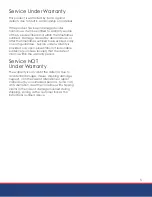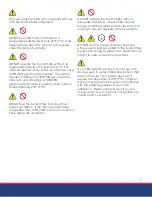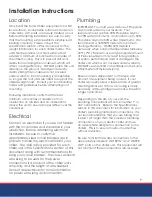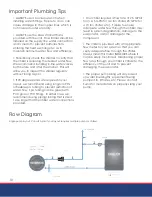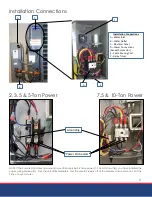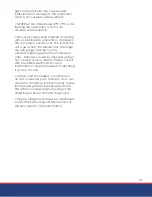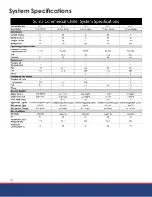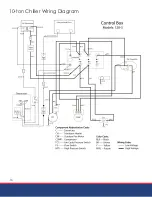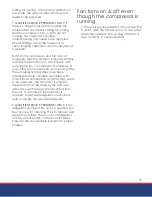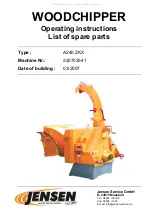
18
1. The unit has a 5-minute delay on start-up
before beginning normal operation. Before
troubleshooting, ensure that 5 minutes have
passed.
2. Check the temperature set-points of the
controller to verify that the desired settings are
still in place. The factory differential temperature
should be 3 degrees, and shouldn’t be changed.
For example, with the factory set differential
temperature setting of 3 degrees, and a desired
temperature setting of 45°F (8°C), the unit will not
start until the water reaches 48°F (9°C).
4. Check to make sure the controller is set to C1.
5.
QUALIFIED SERVICE PERSONNEL ONLY:
Check
voltage at relay (space terminals on each side),
which should be 24VAC while the temperature
controller is calling for cooling, then check for a
loose wire on the controller. If none are found,
check for power at the relay inside the controller.
If you have power there the other cause would
be a tripped high/low pressure sensor, in which
case an HVAC technician will need to service
your unit. He/she should check the refrigeration
pressures with a gauge set to verify that there is
not a problem with system pressures. If no
problems are found with pressure, then the high/
low pressure sensor may need to be replaced.
6.
QUALIFIED SERVICE PERSONNEL ONLY:
Check
the voltage across the ENDS of the main relay
with a meter. This should be 240VAC on each
side when the temperature controller is
Troubleshooting
This unit is equipped with safety sensors that may
include high and low pressure sensors for the
refrigeration circuit and also a flow switch to help
prevent freezing if there is a pump failure or other
loss of flow. If any of these sensors are not
satisfied, they will not allow the chiller to function.
Some of the troubleshooting steps listed below
can be performed by the end user, and some
of these steps must be performed by a licensed
HVAC technician. Retain this guide should your
chiller ever require servicing in the future.
Temperature controller has
no power
1. Check and make sure switch is in the on
position.
2. Check breaker for proper function.
3. Check flow meter for adequate water flow
(2.5 GPM per ton). Insufficient flow will cause
loss of power.
4.
QUALIFIED SERVICE PERSONNEL ONLY:
Check
flow for proper voltage at the unit with an
electric volt-meter.
5. Visually check for any loose wires.
6.
QUALIFIED SERVICE PERSONNEL ONLY:
Remove the front cover of the temperature
sensor and check voltage. If 24 VAC is
present, and all wires are installed and tight,
then most likely the controller will need to be
replaced. If no voltage is present, see the next
step.
7. The controller is wired so that it will not come
on if there is not sufficient water flow to the unit.
If there is no voltage at the controller, check
the flow and verify that the chiller is receiving at
least 2.5 GPM for each ton of cooling required.
If there is sufficient flow, see the next step.
8. Check connections of the flow sensor (the
flow sensor is installed in the water line) to make
Temperature controller
is on, but the unit will not
start
sure you are getting 24VAC across the sensor
while sufficient water is flowing. If there is no
voltage across the sensor leads with a
proper flow-rate, then the sensor needs to be
replaced.
9. Check the direction of flow in the water circuit.
If water is flowing backwards, the flow switch will
not allow power to the temperature controller,
and the unit will not function properly.


